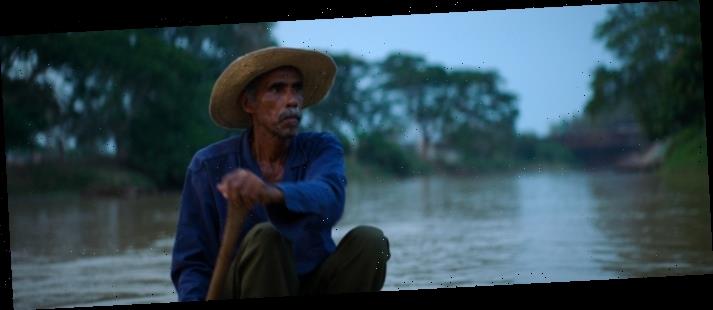“Deliver me from evil,” murmurs fisherman José (Arley De Jesús Carvallido Lobo) into clasped hands before he puts on his hat, steps into his canoe and sets off down the Magdalena River, delivering himself directly into evil. The placid waterway that is the thematic and geographical spine of writer-director Nicolás Rincón Gille’s unfeasibly gripping, slow-scorching feature debut flows through Colombia’s Bolivar region, and back in 2002, when “Valley of Souls” is set, it bore witness to untold barbarism as part of the nation’s drawn-out internal conflict. Gille imagines one such instance of arbitrary violence — tiny in the grand scheme of things — and creates from it a film of astonishing power, as the simple story of José’s quest to find the bodies of his murdered sons quietly floods its banks to become a mythic act of memorialization.
José, having hidden out for the night rather than cross a roadblock set up by the renegade militia, returns home to discover his grown-up daughter weeping in the underbrush, a “Death and Purification” slogan from The United Self-Defenders of Colombia (AUC) sprayed onto a shack, and his two sons, Rafael and Dionisio, taken. There is no question of their still being alive. But somehow crueler than this unimaginable tragedy is that the devout, decent José has no earthly remains to bury, and so, uttering a prayer to St. Anthony, the finder of lost things, he vows to locate them. He knows they will have been discarded in the cloudy waters: For the AUC, the river is both Styx, the river of hate, and Lethe, the river of oblivion, and lest anyone refuses to forget about the secrets it carries, they have also declared the removal of bodies from it a transgression punishable by death.
For José, the river that used to be his livelihood is now Acheron, the river of sorrow. At first, it seems like St. Anthony might have been listening: José comes upon Rafael’s body relatively quickly, and it becomes an oddly comforting companion to him in the canoe as they look for his brother. But Dionisio is not so easily found. José’s stoic search turns into an odyssey, its loneliness punctuated only by increasingly perilous encounters, including one nerve-shreddingly tense and strange episode in the belly of the militia beast, when it’s only Jose’s childhood fondness for competitive cycling that stays his likely execution, and even then he must withstand the unusual torture of being forced at gunpoint to eat bowl upon bowl of thin soup.
You could see shades here of a few neo-westerns — the grisly companionship of “Bring Me the Head of Alfredo Garcia”; the spare, doomed, floating rhythm of Jim Jarmusch’s “Dead Man.” And the way the swampy air feels thick with faith, phantasm and fear recalls fellow Colombian Ciro Guerra’s masterful “Embrace of the Serpent.”
But to Gille’s credit those reference points don’t really occur to you while you’re watching: All of the considerable artistry of “Valley of Souls” goes toward making it so completely immersive you can forget there’s artifice at all.
Instead, despite the stark splendor of the cinematography, DP Juan Sarmiento G.’s miraculously unobtrusive camera seems to erase itself from the process altogether, while Edson Secco’s scoreless sound design envelopes us in the unfolding moment. And so few words are spoken that the screenplay has all but evaporated too. All there is is José’s mission, etched into his weather-sculpted face, his fathomless black eyes and the sinews of his tanned shoulders. A nonprofessional in his first film, Lobo gives a riveting performance destined to garner little attention because it is so massive as to be invisible: At times he feels less like a character in a movie than an expression of pure, single-minded will, given human form.
As for iconography, there is a forlorn poetry in the objects that José clings to in place of his stolen kin: the gaudy knockoff football T-shirt, in the Brazil colors, emblazoned with his name, the boxing-glove pendant that he takes as a token from the body of a luckless friend. These items are like religious relics, but their talismanic power is limited, just like that of the saints and of God Himself out here in this beautiful place in these brutal times. If you pray very hard and mortify your flesh to its physical limit, their sorrowful magic can perhaps return your loved ones’ lifeless bodies to you, but it cannot keep them alive.
Already this year Colombia’s “Monos” has created a stir on the art-house circuit, and “Valley of Souls” dovetails perfectly with that more clamorous film, as an equally accomplished yet radically different tale of victimhood and survival from the nation’s stricken recent history. Such acts of remembrance are vital, as we’re reminded when, in a closing credit, Gille thanks “all those who agreed to revisit these dark times.” The survivors of Colombia’s decades of conflict may have little by which to remember the dead, maybe not even a body or a headstone, but now there is “Valley of Souls” — a quiet, reverent monument at which to gather and grieve.
Busan Film Review: 'Valley of Souls'
Reviewed at Busan Film Festival (Flash Forward), Oct. 5, 2019. Running time: 136 MIN. (Original title: “Tantas Almas”)
Production:(Colombia-Belgium-Brazil-France) A Medio de Contención Producciones production in co-production with Neon Rouge, NRW SPRL, STO Lat Films and Tact Prod. (Int’l sales: Best Friend Forever, Brussels.) Producers: Hector Ulloque Franco, Manuel Ruiz Montealegre.
Crew:Director, screenplay: Nicolás Rincón Gille. Camera (color, widescreen): Juan Sarmiento G. Editor: Cedric Zoene.
With:Arley De Jesús Carvallido Lobo, Carlos Enrique Avila Argota, Maria Amanda Vargas Barbosa, Emil Quitero Contreras, Oscar Carvallido Cuellar, Alfonso Javier Hernandez Lopez, Jose Enrique Vasquez Hernandes, Pedro Julio Arias, Carmen Munoz de Mora, Lissy Johanna Meneses Rodriguez, Carlos G Vergara Montiel, Maria Ines Mejia Castano. (Spanish dialogue)
Source: Read Full Article
